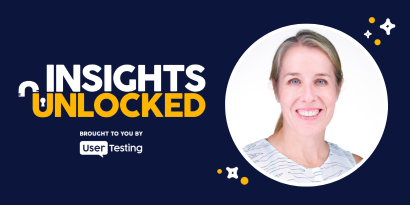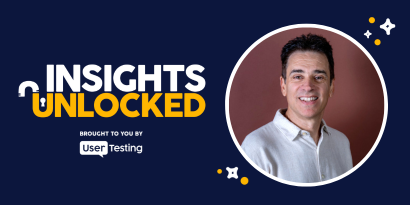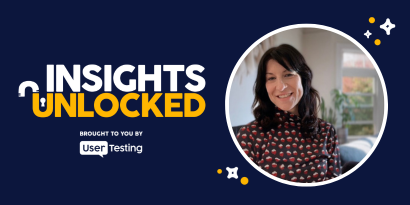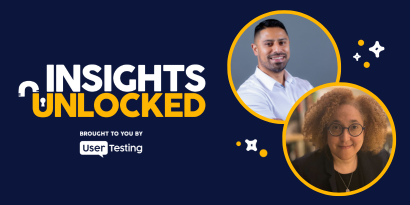
Episode 178 | July 07, 2025
How empathy in marketing can unlock your brand’s higher purpose
Discover how empathy and purpose can transform your marketing with insights from aiCMO co-founder Steven Sakach.
How empathy in marketing can unlock your brand’s higher purpose
Most marketing campaigns focus on grabbing attention. But what if the secret to lasting impact isn’t just being heard—but being felt?
That’s exactly what Steven Sakach, co-founder of aiCMO and CEO of Zero Company, unpacks in a recent episode of Insights Unlocked. With a background that spans journalism, digital marketing, and human consciousness studies, Steven’s journey is anything but ordinary. And neither is his message: empathy in marketing isn’t a tactic—it’s a transformative mindset.
In his conversation with host Nathan Isaacs, Steven lays out why purpose-driven marketing is more than a feel-good concept. It’s a strategic advantage that helps brands connect more deeply, resonate more authentically, and build systems that scale love, not just sales.
Why empathy belongs at the center of your marketing
Empathy in marketing isn't just about crafting emotional ads or feel-good messaging. According to Steven, it's about aligning your business with a higher purpose and letting that purpose guide every decision—especially the ones that impact your customers.
“What we’ve seen in conscious capitalism,” he explains, “is this move from modern to postmodern thinking. It’s not just about the investor or owner anymore. Now, you make decisions through a lens that includes employees, customers, partners, community, and the environment.”
This expansion of perspective, he says, is what separates brands like Patagonia or Dove from others—they’re not simply selling products; they’re advancing a mission. “Purpose becomes the boss,” Steven adds. “You start to align every decision around it. And that’s where marketing becomes more empathetic and more powerful.”
ON-DEMAND WEBINAR
Unlock higher conversions: understanding what users really want
Purpose-driven marketing is more than a buzzword
When Nathan brings up how rare it is to see companies fully embrace this model, citing examples like Ben & Jerry’s and its transition from founder/owner to global corporate ownership, Steven acknowledges the difficulty. Especially when businesses scale or bring in leaders with a purely profit-driven mindset, things can quickly regress.
“You can see it like a regression in consciousness,” Steven says. “When someone steps in with that older thinking—where profit is the only metric—everything breaks down.”
That’s why defining a company’s higher purpose early is so essential. And it has to be more than just a mission statement. “You’ve got to be about it,” he says. “This generation, especially, will sniff out the B.S. instantly. If you’re not walking the talk, it backfires. Badly”.
The marketing power of emotional connection
Steven cites a staggering stat that underlines this philosophy: businesses that make a strong emotional connection with customers increase their lifetime value by 306% over merely satisfied customers.
That kind of loyalty isn’t born from flashy ads or clever taglines. It comes from building authentic relationships and showing that your brand stands for something real. “Marketing doesn’t stop at the sale,” he says. “There are 17 consumption emotions—and your job is to stay on the positive side of those. That’s where surprise and delight come in.”
To help brands do that consistently, Steven and his team developed the aiCMO—a platform designed to help marketing teams scale empathy through AI-powered insights, prompts, and creative direction. But even that, he says, is only effective when businesses are truly aligned with their purpose.
Can artificial intelligence make us more human?
It might sound like a contradiction: using AI to be more empathetic. But Steven sees it differently.
“Most people think of prompting AI. We want AI to prompt us—to be more empathetic, to be more aligned with our higher purpose,” he explains. “If we’re only optimizing for conversion, we can steer toward the wrong goals. AI is powerful, but it needs the right kind of guidance”.
That’s why aiCMO doesn’t just churn out copy—it starts by helping users articulate their brand’s higher purpose through prompting questions and interactive tools. Once that’s clear, the platform uses that purpose as guardrails to generate ideas for campaigns, content, and customer experiences that align authentically.
Think of it like tuning an instrument. If your purpose is your pitch, AI becomes your amplifier—not your composer.
The risk of performative empathy
One of the most insightful parts of the conversation is when Nathan and Steven discuss brands that try to emulate purpose-led messaging but miss the mark. The infamous Pepsi ad featuring Kendall Jenner comes up—a classic case of a brand pandering to social movements without any real credibility.
“That’s the danger,” Steven says. “If you're not truly about it, people see right through it. Authenticity can’t be faked—not anymore. The audience is too savvy”.
He contrasts this with Dove’s famous Real Beauty campaign, which launched 21 years ago and is still going strong today. “They’ve never strayed from their purpose. That’s why it worked then, and why it still works now. They didn’t just jump on a trend—they put good into the world through billions of ad impressions”.
How to rediscover your purpose (even if you’ve lost it)
Many companies start with passion but lose their way as they grow and scale. That’s natural, says Steven—but it’s not irreversible.
He offers a mantra to guide the journey: BLISS, which stands for Build Love Into Scalable Systems.
By asking, “How can I build love into this?,” at each stage of a campaign or customer interaction, brands can realign themselves with what matters. It also helps uncover the emotional “why” behind their products and services.
Nathan draws a great parallel from his own experience on submarines in the Navy: “We’d surface every six hours or so to get a GPS fix. Even being one or two degrees off course could take us miles off track over time. It’s the same with marketing. You’ve got to keep checking if you’re still aligned with your true purpose.”
The co-creation opportunity: inviting your audience into the journey
Purpose doesn’t have to be a static idea defined only by the leadership team. In fact, Steven encourages brands to think of it as a co-creative process with their audience.
“If you're transparent about your goals—even if you're still figuring it out—people will respect that,” he says. “They'll join you. They’ll offer ideas. It becomes a community effort, and that builds trust faster than any campaign ever could.”
That level of honesty and openness might feel risky, but it’s the kind of risk that pays off in the long run—especially with younger, more purpose-driven consumers.
What marketers can do today to move toward empathy and purpose
If you’re a marketer or brand leader wondering how to take action on these ideas, start here:
- Audit your purpose: Does your mission reflect what you really stand for today?
- Ask deeper questions: What positive difference does your business make in people’s lives?
- Involve your team: Empathy starts internally. Invite employees to help define your values.
- Be transparent: Share your journey openly, even if it’s imperfect.
- Use AI wisely: Let it prompt you toward empathy, not just efficiency.
- Surprise and delight: Look for moments to exceed expectations and connect emotionally.
- Measure what matters: Look beyond clicks and conversions. Track emotional engagement and loyalty.
Final thoughts: leading with love
Steven’s message is clear: the most effective marketing doesn’t just persuade—it connects. And that connection is built on empathy, purpose, and the courage to show up authentically.
As he puts it, “My higher purpose is to help people build love into some kind of a system. Don’t let it just be a random act of kindness. Make it part of how your business runs. Little by little, a little becomes a lot.”
Episode links
- The ROI of empathy for marketers: Explore how customer empathy serves as a business differentiator. This webinar delves into strategies for incorporating empathy into customer experience decisions and connecting ROI to empathy through measurement.
- Unlocking campaign effectiveness: a step-by-step guide to driving impact before launch: This guide provides a framework for optimizing messaging, creative, and targeting before launch, ensuring every campaign is set up to perform at its best. It emphasizes the importance of understanding customer motivations and expectations.
- Winning at zero-click marketing starts with customer empathy: In this episode of Insights Unlocked, Rand Fishkin discusses the demise of attribution, the rise of zero-click marketing, and how to understand customer behavior in a data-restricted world, emphasizing the role of empathy.
- Why (and how) marketers should build empathy for their customers: This blog post outlines practical strategies for marketers to build empathy, understand customer needs, and create more resonant messaging.
- aiCMO – Steven’s AI-powered marketing platform
- Zero Company – Steven’s marketing agency
- Bliss Business Podcast – Steven’s podcast about building love into business
- Steven on LinkedIn
- Nathan on LinkedIn
GUIDE









